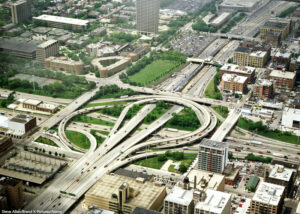![Showing reconstruction in [the Greenwood District of] Tulsa, Okla. This part of town was demolished by fire in the race riots of June 1921 Building reconstruction in Tulsa, Okla. This part of town was demolished by fire in the race riots of June 1921.](https://mhebtw.mheducation.com/wp-content/uploads/2022/02/022122_02P_FS-678x381.jpg)
The Tulsa Race Massacre took place just over a hundred years ago. Hundreds of African Americans died, and an entire Oklahoma neighborhood was destroyed. Today, that same neighborhood faces another challenge to its success. Here, btw takes a closer look at the development–and redevelopment–of this historic neighborhood over time and the challenges it continues to face today.
A Race-Based Massacre
On May 31 and June 1, 1921, the Greenwood area of Tulsa, Oklahoma, was nearly wiped out by a race massacre. The Greenwood District was a thriving 35-block area of African American-owned businesses and residences. It was also called Black Wall Street because of the businesses and income concentrated in this area. On May 30, 1921, an African American man named Dick Rowland was accused of inappropriate conduct with a white woman named Sarah Page. This story spurred on a violent confrontation that left as many as three hundred people dead, thousands displaced, and the Greenwood District largely burned to the ground.
But that’s not the end of the story. The people of Greenwood rebuilt the area after the massacre, so that it was even larger and more prosperous than before. After the 1921 upheaval, more than half of the homes and businesses in the Greenwood district were in disrepair, and many survivors moved out of the area to start fresh somewhere else. Those who stayed managed to rebuild their lives. By the 1950s and 1960s, the Greenwood District had again become one of the most successful African American neighborhoods in the country.
A History of Economic Inequality
When the neighborhood was rebuilding, the district was 35 city blocks of businesses and homes. There were many grocery stores, schools, churches, and homes that made up the area. However, the neighborhood was affected again when the modern highway system was planned and constructed through the neighborhood in the 1960s and 1970s. The federal government used the power of eminent domain to force the owners to sell their property. The highway divided the neighborhood and eliminated many of the businesses that helped support the community.
In recent decades, redevelopment and gentrification has changed the western area of the Greenwood district. Gentrification is the process of changing a typically poor, urban neighborhood with new housing and new businesses. But these new houses and businesses are typically owned by wealthier middle- and upper-class people. The original neighborhood families are pushed out by these economic changes. Tulsa’s nearby arts district has experienced its own growth in new restaurants, art galleries, and other economic improvements.
These changes are now affecting the western part of the Greenwood district. The African American-owned businesses that rebuilt the area from the 1920s into the 1960s are disappearing. This type of economic change and downtown urban renewal is not only happening in Tulsa, but also in many U.S. cities. But white and African American businesses are not able to compete for in the new gentrified neighborhoods equally. That is because historical economic inequalities over past generations make it more likely for expanding businesses to be white-owned, with more economic flexibility to expand into developing neighborhoods.
What Can Be Done?
Right now, Oklahoma state law requires that decisions about loans and business incentives to developers be made without attention to race. But African American residents of Tulsa argue that race should absolutely be considered to achieve greater racial equity. Several residents have even filed a lawsuit demanding that the city supply the area with the basic amenities it needs to succeed–such as schools, grocery stores, jobs, and housing, which have been lost as white developers take over the area. The lawsuit even argues that the Tulsa Race Massacre itself continues to disenfranchise African American residents today, as the city and white developers profit from increasing tourism to the area because of the Massacre.

